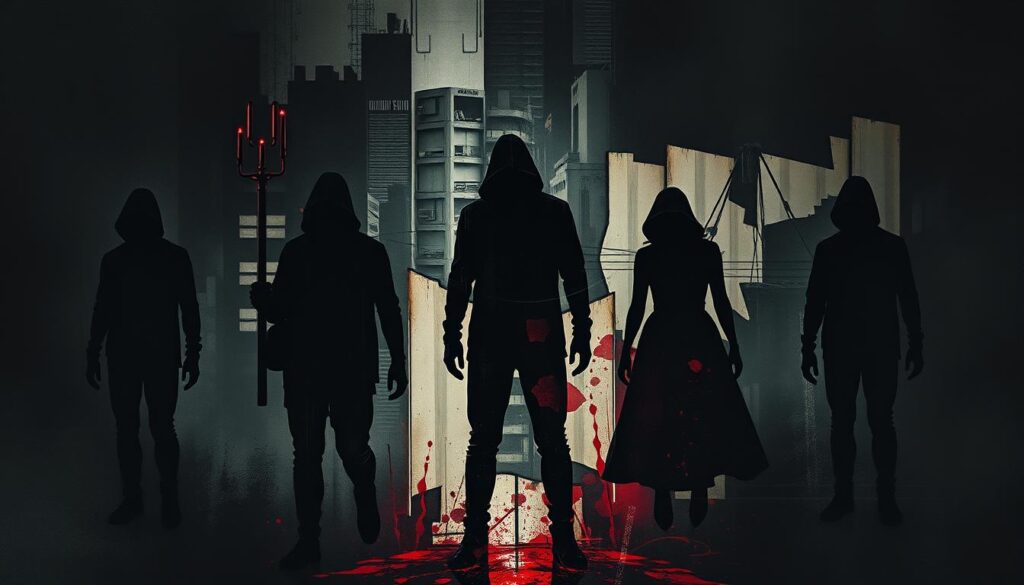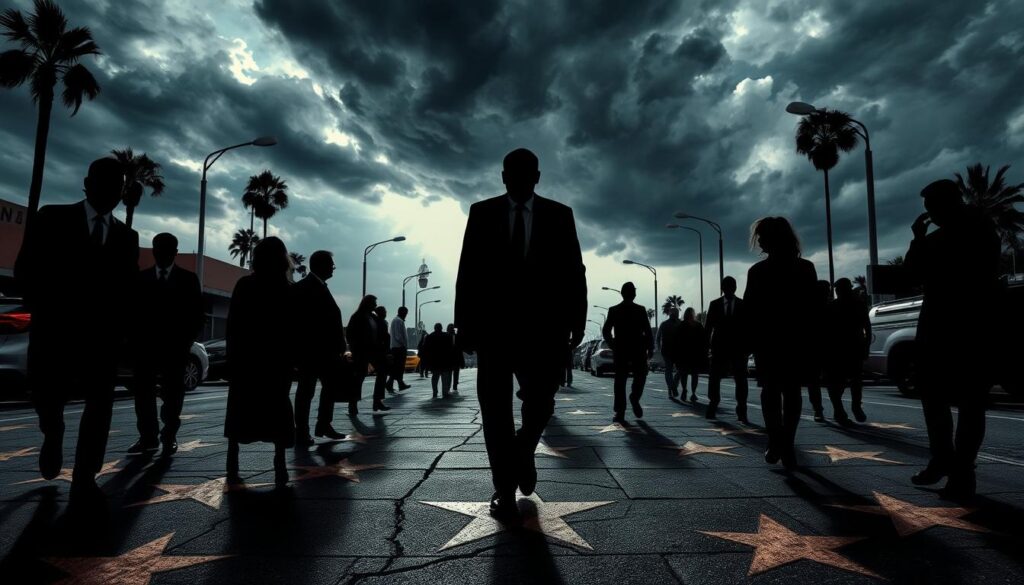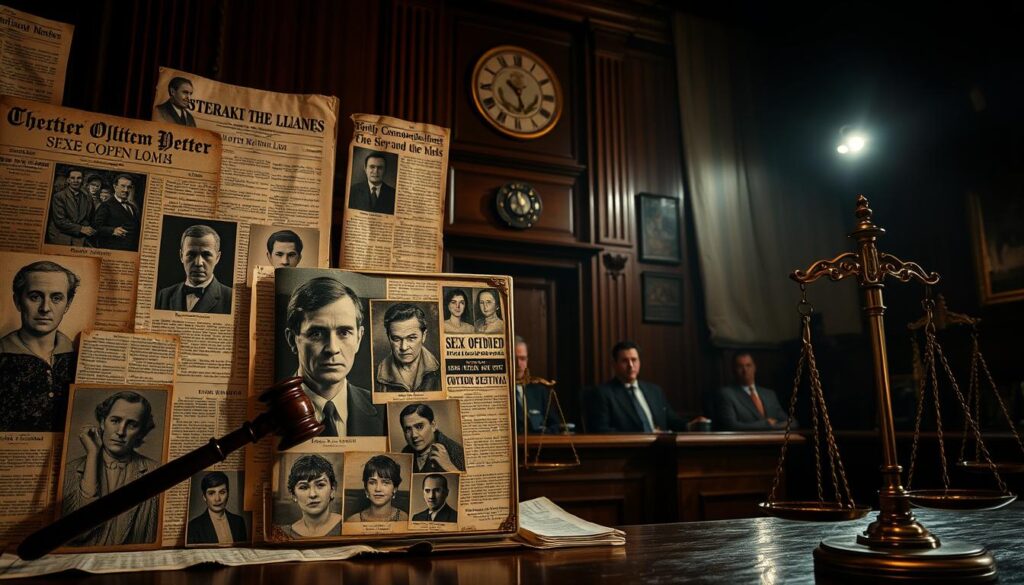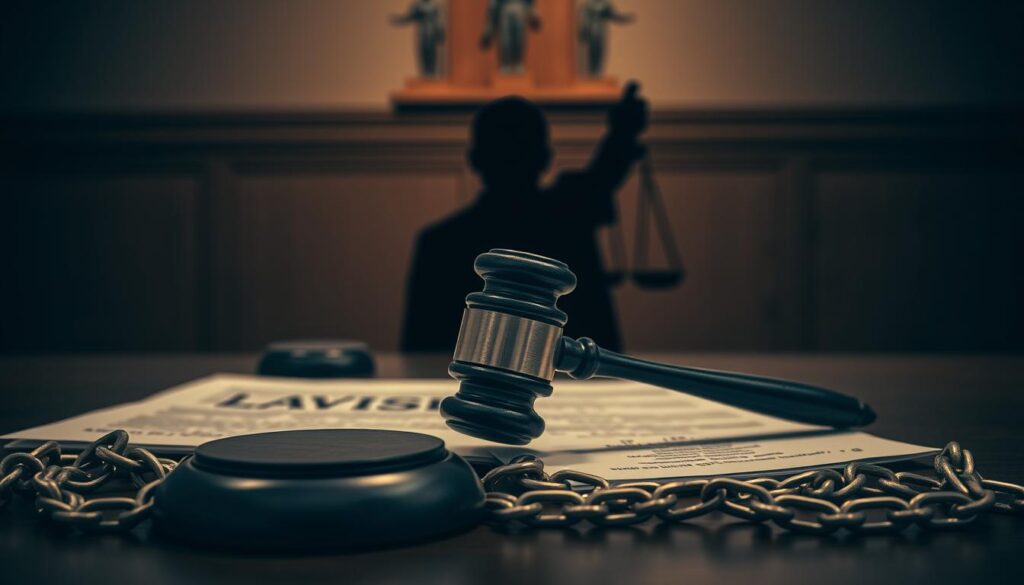When shocking crimes hit the news, it’s common to feel removed from the horror. Yet, these incidents impact our communities, families, and our personal safety. The subject of famous sex offenders brings fear and anger. But, understanding and awareness are crucial.
Identifying sex offenders isn’t just about names. It’s about recognizing patterns for prevention. By 2016, the U.S. had nearly 860,000 registered sex offenders. Their crimes range from minor to severe.
This vast number highlights why knowledge is key for protection. This article explores the distinction of famous sex offenders, changes in societal views, and our collective fight against sex crimes.
Key Takeaways
- Understanding the scale and nature of sex offenses is crucial for community awareness.
- Juvenile offenders represent a substantial percentage of registered sex offenders.
- Registration requirements can vary significantly between states, influenced by the severity of crimes.
- Historical laws like the Jacob Wetterling Act have shaped the current landscape of sex offender registries.
- Being informed about sex offenders helps enhance personal and community safety.
- Community discussions can foster better protection and support for victims of sexual offenses.
Understanding Sex Offenders
A comprehensive understanding of sex offenders starts by knowing their categories. These include juvenile offenders, those guilty of child exploitation, and sexual assault criminals. Each type presents unique challenges and risks. This requires specific prevention and treatment strategies.
Research shows concerning trends in sex crime statistics. For example, treatment helps reduce reoffending, making it vital to match treatment with the offender’s risk level. Also, 60-80% of sex offenders have at least one mental health issue. This makes their rehabilitation more complicated.
Studies show differences in reoffending risks. Offenders over 50 are less likely to reoffend than younger ones. Another study points out that gender affects recidivism rates, with males reoffending more than females. This underscores the need to understand each sex offender’s psychological profile and behavior.
Around 30% of sexual offenders were abused as children. This suggests a link between early victimization and later offenses. Also, about 73% of male teens abused sexually may later become abusers. This indicates a vicious cycle of abuse.
| Type of Offender | Key Characteristics | Recidivism Rate |
|---|---|---|
| Child Molesters | Target minors, often use grooming | Higher than other categories |
| Rapists | Use force, often motivated by power | Varies, generally lower with aging |
| Female Offenders | Often involve manipulation and deceit | Lower overall, specific profiles |
| Child Pornography Offenders | May not engage in hands-on abuse | 34% may also victimize directly |
In conclusion, knowing the different types of sex offenders and their statistics is crucial. It helps in creating effective prevention and treatment plans. Recognizing these complexities helps in developing better rehabilitation and public safety procedures.
Characteristics of Sex Offenders
Understanding the behavior of sex offenders is key to prevention and intervention. They often show specific psychological traits that act as warning signs. Trauma or substance abuse history is common among many sex offenders. This background increases their chance of offending again.
About 30% of sexual offenders may commit the same crimes again. They tend to follow a cycle in their behavior.
There are several red flags to spot potential offenders. A significant fact is that victims usually know their assailants. This means we should be careful in relationships, as about 75% of sexual offenses are by someone known to the victim.

Statistics show issues like intimate partner violence, sexual assault, and stalking affect many, regardless of their sexual orientation. Native American women, for example, have alarming rates of sexual violence. Nearly half report experiencing such violence in their lifetime.
Compared to those who commit other types of crimes, adult sex offenders are more likely to reoffend. This highlights the need for thorough assessments and careful monitoring of these individuals.
Profiles of sex offenders often mix developmental and psychological factors. Characteristics like psychopathy, Machiavellianism, and narcissism are common. This “dark triad” is linked to more violent crimes, which is crucial to remember when identifying potential dangers.
| Characteristic | Statistic |
|---|---|
| Sexual assault prevalence among women | 1 in 5 women |
| Sexual assault prevalence among men | 1 in 71 men |
| Percentage of victims who know their offenders | 75% |
| Reoffense rate of sexual offenders | 30% |
| Registered sex offenders in the U.S. | 800,000 |
How the G7 Initiative Targets Child Sex Offenders
The G7 Initiative is a group effort by countries to fight child sex crime. These nations are working together to find, catch, and bring to trial those who harm children. The initiative gets help from the United States. Agencies like the U.S. Marshals Service and the National Sex Offender Targeting Center are crucial.
Around the world, 1 billion children face violence every year. This fact shows how important it is for countries to work together against these terrible acts. The G7 Initiative helps by sharing information, making better tracking systems, and creating fast-acting policies.

Gathering data is a key part of the G7 Initiative. For example, a survey with 20 countries looked at child violence. This shows the need for more effort to understand these issues. Countries in this initiative want to find solutions based on facts. Already, 23 countries have started successful programs to help young girls.
This initiative uses teamwork to make prevention better and laws stronger. It’s not just about stopping child sex offenders. It aims to reduce all violence against kids, especially the most at-risk. The main goal is to make the world safer for children everywhere.
Most Famous Sex Offenders
The topic of famous sex offenders brings to light some very serious cases. These cases have made people more aware and sparked action against sex crimes. By looking at these offenders, we understand the serious nature of their actions and their impact on society.
Overview of Notable Cases
Bill Cosby is a well-known sex offender, accused by over 60 women. His situation shows how many allegations can lead to major legal problems. Harvey Weinstein, on the other hand, was found guilty of rape and assault. Though he was first sentenced in New York, he faces more court time due to an appeal.
R. Kelly received a long jail term in New York and Chicago for sexual violence. His cases highlight the issue of sexual violence in the entertainment world. Sean “Diddy” Combs faces serious charges as well. He could be facing at least 15 years in federal prison if found guilty of sex trafficking and racketeering.
Danny Masterson was sentenced to 30 years to life for multiple rape counts. These high-profile cases help society talk about justice and holding people accountable.
Impact on Society and Victims
The effect of sex crimes goes beyond what the offenders face. These incidents have changed how people see these crimes, leading to more awareness and calls for change. The #MeToo movement has been vital in showing the reality of allegations versus convictions. Despite many allegations, few lead to charges, showing a gap in justice for victims.
Victims face challenges in finding justice and support in a complex society. The stories of these offenders highlight important conversations about gender, power, and the justice system’s response.

| Offender | Charges | Conviction Outcome |
|---|---|---|
| Bill Cosby | Sexual assault | Convicted; 60+ allegations |
| Harvey Weinstein | Rape, sexual assault | Convicted; retrial pending |
| R. Kelly | Sex trafficking | 30 years; multiple convictions |
| Sean “Diddy” Combs | Sex trafficking, racketeering | Pending; potential 15 years |
| Danny Masterson | Rape | 30 years to life |
Recent Trends in Celebrity Sex Offender Cases
The Me Too movement has reshaped how we see celebrity sex offenders. It has enabled many victims to speak out. This trend is evident in the entertainment industry’s push for responsibility.
Bill Cosby faced claims from over 60 women, showing how abuse can be ignored for years. Similarly, Harvey Weinstein was convicted in 2020, highlighting the movement’s influence. Celebrities are now held to a new standard.
R. Kelly’s legal issues show the widespread nature of such crimes in Hollywood. These cases underline the public’s need to keep an eye on celebrities.
Some celebrities, like Kevin Spacey, manage to avoid punishment, even after serious charges. On the other hand, Louis C.K. confessed to his wrongdoings. This hurt his career greatly.
Today’s world is more aware of sexual assault and exploitation problems. But, while some stars remain popular, many victims are still fighting for justice. This shows a concerning lack of responsibility.

| Celebrity | Charges/Allegations | Status | Year(s) Involved |
|---|---|---|---|
| Bill Cosby | Sexual assault, drug-facilitated abuse | Convicted | 1980s – 2020 |
| Harvey Weinstein | Sexual assault | Convicted (23 years) | Multiple decades until 2020 |
| R. Kelly | Racketeering, sex trafficking | Pending | 1990s – Present |
| Kevin Spacey | Sexual harassment, assault | Acquitted | 2017 – 2023 |
| Louis C.K. | Sexual misconduct | Admitted, career fallout | 2017 |
| Jeffrey Epstein | Sex trafficking | Deceased in custody | 2000s – 2019 |
These cases show changing discussions on consent, power, and responsibility. The focus on celebrity sex offenders shows a bigger drive to tackle sexual exploitation.
Historical Context of Famous Sex Offenders
Understanding the history of famous sex offenders helps us see how laws have changed. We see society’s views shift and legal actions get tougher with cases like Jimmy Savile and Jeffrey Epstein. These cases fuel discussions on justice and how we hold offenders accountable.
Notable Convictions and Legal Outcomes
In 2012, the world learned about Sir Jimmy Savile’s decades of abuse. This came out after his death. His case made more people come forward, leading to a 22 percent rise in reported sexual offenses in England and Wales, say the Office for National Statistics.
Rolf Harris and Max Clifford also faced justice for their crimes. Harris was sentenced to nearly six years for indecent assault. Clifford got eight years for assaulting young women. Their cases show a stronger push against sexual offenders.
Jeffrey Epstein’s case shows how tricky justice can be for powerful people. In 2008, he got only 18 months for serious charges. But widespread criticism followed, especially after his high-profile connections were revealed. His 2019 arrest for sex trafficking brought more attention to his crimes and the victims affected.
Cases like Cyril Smith and the Rotherham scandal highlight long-term societal impacts. Smith’s crimes were debated for over 40 years. In Rotherham, 1,400 children were identified as victims over 16 years. These cases underline the lasting effects of crimes by well-known figures.

The Role of Media in Highlighting Cases
How sex offender cases are shown in the media is very important for public awareness. Recently, there’s been more news using phrases like “sex offender” and “sex predator.” This increase in stories has changed how people and lawmakers see these cases.
The worry about sex offenders has grown because of scary child abduction stats. U.S. Representative Paul Simon said about 50,000 kids are taken by strangers every year. Reports also say around 5,000 of these children are killed. This makes people and lawmakers want much stricter rules.
The media’s focus on big sexual offense cases has caused a lot of fear. This fear leads to tougher laws in many places. Offenders are often seen as “monsters,” leading to longer jail times and strict rules after they’re released. But this can ignore the details of each case and how to help offenders get better.

Looking at how media affects things, we see both problems and improvements in reporting. Studies now show media is starting to talk about the rights of sex offenders too. By discussing case details and expert views, the goal is to educate, not scare. This shows how discussions on sex offenders in society are slowly changing.
| Media Influence on Legislation | Public Perception | Legislative Changes |
|---|---|---|
| Increased media coverage of violent sexual offenses | Perception of offenders as extreme threats | Stricter laws such as community notification |
| High-profile cases dominating headlines | Fear-driven public support for severe measures | Civil commitment laws in numerous states |
| Focus on individual cases seldom presented | Generalization of all offenders as dangerous | Emerging discussions on human rights |
| Shift towards expert opinions in reporting | Increased skepticism of traditional narratives | Potential future revisions to legislation |
Looking into these aspects helps us understand the media’s two roles. It raises awareness but can also twist how we see sex offenders. This balance is key in how we deal with sex offender cases now and in the future.
Common Misconceptions About Sex Offenders
Society often misunderstands sex crimes, clouded by myths about sex offenders. These false beliefs create stigma and block useful talks on prevention and help. It’s key to know what’s true and what’s not.
Many think sex offenders usually don’t know their victims. But, reports from the Bureau of Justice Statistics show otherwise. Only 7% of child sex crimes involve strangers. This highlights the importance of vigilance in familiar settings.
There’s also a wrong idea that sex offenders will always commit more crimes. Yet, data shows that over 87% do not offend again. Studies find that proper treatment can make re-offending even less likely. Treatments can lower repeat offenses by up to 59%.
Some believe harsh penalties are the best way to stop sex crimes. But, evidence shows these measures aren’t very effective. Studies prove that tough laws don’t greatly reduce sex offenses.

Breaking down these myths is crucial for understanding sex crimes better. Teaching the public about these errors helps. Communities can then aim for solutions that focus on helping rather than shaming.
Legal Implications for Convicted Sex Offenders
The rules for sex offenders are complex and different in each state. They must follow strict registration laws and add their names to a sex offender list. This not only alerts the community but also has serious legal consequences. These can change many parts of their lives.
In Georgia, breaking registration rules the first time can lead to a felony charge. This might mean up to 30 years in jail. If they break the rules again, the consequences are even tougher, with no chance for parole. Over 200,000 people in the USA are registered as sex offenders. This shows how widespread these sex offender laws are.
| Name | Year of Conviction | Sentence | Legal Consequences |
|---|---|---|---|
| Bill Cosby | 2018 | 3 to 10 years in prison + $25,000 fine | Mandatory registration |
| Harvey Weinstein | 2020 | 23 years in prison | Mandatory registration |
| Mike Tyson | 1992 | 3 years in prison | Registered sex offender since 2002 |
| Jerry Sandusky | 2012 | 30 to 60 years in prison | Mandatory registration |
| Roman Polanski | 1977 | 42 days in jail | Registered sex offender |
There’s more to the legal consequences than just jail time and having to register. Being on the sex offender list often means facing a big social stigma. It can make finding jobs and homes very hard. Many end up homeless, more so than other people.
Society’s views on sex offender laws keep changing. Movements like Me Too are making people pay more attention to sexual offenses. They lead to more reports and legal actions against those who were untouchable before. Knowing about these legal matters helps us understand the effects of sex offenses on offenders and society.

Protecting Yourself From Potential Offenders
Today, it’s crucial to focus on personal safety. The concern for potential sex offenders is always there. Knowing the signs and how to act can keep you and others safe. This section shares tips on spotting danger and creating a safe space.
Recognizing Warning Signs
To guard against sex offenders, know the warning signs. Recognizing these can guide you to safer choices. Look out for these behaviors:
- Inappropriate behavior: Watch out for too personal or suggestive actions, especially towards minors.
- Excessive secrecy: People overly secret about their lives should raise suspicions.
- Interest in children: Be wary of adults too interested in children without good reason.
- Boundary violations: Notice if someone often makes others uneasy by ignoring social limits.
- Control tactics: Manipulative actions are red flags. Stay on your guard.
Trust your feelings when you see these signs. Always keep your safety and others’ first. Take steps if you feel threatened or uneasy.
Boost your safety in public places by staying aware. Knowing your environment helps avoid dangers. Carrying a whistle or other safety tools can help protect you.
Self-defense classes are another good idea. They teach you how to protect yourself. Places like community centers offer these classes, giving you confidence and skills.
Having support is key. If you think someone is following you, tell people nearby. Talking about safety with others can make everyone safer and build trust.

| Warning Sign | Description | Action to Take |
|---|---|---|
| Inappropriate behavior | Suggestive actions towards others, especially minors | Report to authorities if necessary |
| Excessive secrecy | Reluctance to share personal information | Maintain distance; observe further |
| Interest in children | Unusual focus on young individuals | Monitor the situation; inform parents or guardians |
| Boundary violations | Constantly trespassing social norms | Communicate discomfort; distance yourself |
| Control tactics | Manipulative behaviors that evoke fear | Seek assistance from others or authorities |
By learning these signs and taking steps, you help make a safer space for everyone. Remember, knowing is the first step in protection against sex offenders.
Resources for Victims of Sexual Offenses
Getting the right support is key for those hurt by sexual crimes. Without it, healing can be tough for survivors. There are many services out there to help them heal and feel powerful again.
RAINN is a leading group that helps victims of sexual violence. As the biggest anti-sexual violence organization in the U.S., RAINN gives victims many ways to get support. Their National Sexual Assault Hotline at 800.656.HOPE (4673) is open for anyone who needs to talk or find help quickly.
The National Domestic Violence Hotline is also available all day, every day, at 1.800.787.7233, with support in over 170 languages. For Americans abroad, the Americans Overseas Domestic Violence Crisis Center offers help, too.
There are special resources for sexual assault survivors, such as:
- VictimConnect Resource Center: Call 855.484.2846 for info on rights and where to find help.
- Joyful Heart Foundation: Works to stop sexual assault and helps those affected.
- DoD Safe Helpline: Supports members of the Department of Defense community facing sexual assault.
RAINN also works with over 1,000 local service providers across the country. This network makes sure survivors get help that fits their needs.

| Resource | Contact Information | Services Provided |
|---|---|---|
| RAINN National Sexual Assault Hotline | 800.656.HOPE (4673) | Emotional support, crisis intervention |
| National Domestic Violence Hotline | 1.800.787.7233 | Support in over 170 languages |
| VictimConnect Resource Center | 855.484.2846 | Rights, resources, referrals |
| DoD Safe Helpline | Available through DoD channels | Support for military personnel |
| Americans Overseas Domestic Violence Crisis Center | Toll-free hotline in 175 countries | Support for individuals abroad |
These resources are crucial for victims’ recovery. Seeking help can empower them to restart their lives and pursue justice.
Conclusion
As we conclude our look at high-profile sex offender cases, it becomes clear that knowing the complex details is key. This summary points out how vital ongoing learning and staying alert are in protecting ourselves and our neighborhoods. Stories like those of R. Kelly show us the big effects on society and the constant need for ways to prevent these crimes.
It’s shocking to learn that many sexual offense cases don’t get reported. Studies show that only 25% of rapes are reported to the police. This shows the big challenges victims face in getting justice. It also shows why it’s so important to keep teaching people about these issues. Everyone has a part to play in talking about victim protection and rights.
Being informed and taking action makes our communities safer for all. Remembering how key prevention methods are influences both individuals and our society. As more people become aware and keep these important discussions going, we can create a world where everyone feels secure and defended.










